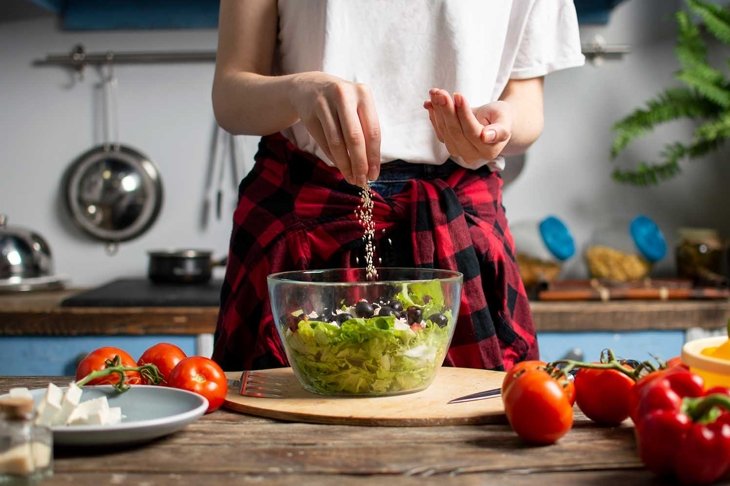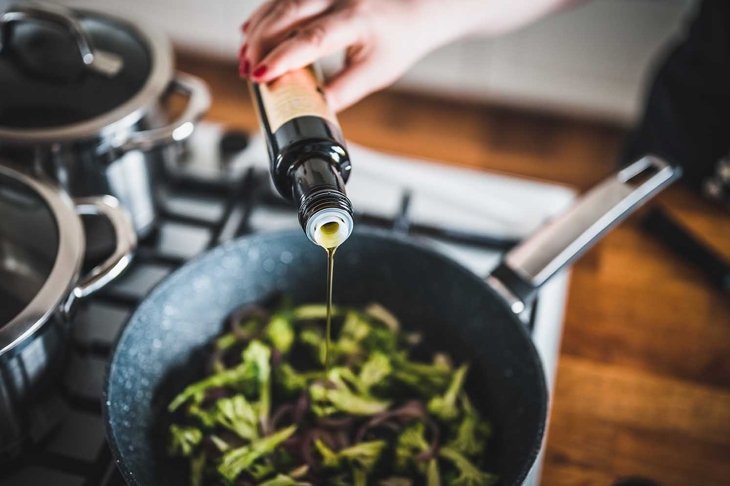
From finding that inspired recipe to carefully selecting all the ingredients to spending a little extra on organic to taking the time to cook, you likely put a lot of effort into making healthy meals. Unfortunately, simple things that many people do in the kitchen can make those meals a little less healthy than intended. Here are 10 common mistakes you may be making in the kitchen that derail healthy eating.
01
Seasoning with too much salt
 More than 30 percent of cases of high blood pressure are estimated to be due to high sodium intake. While it is recommended that adults get about one teaspoon of sodium per day, most people get double this daily amount.
More than 30 percent of cases of high blood pressure are estimated to be due to high sodium intake. While it is recommended that adults get about one teaspoon of sodium per day, most people get double this daily amount.
To lower sodium in your own cooking, swap out salt with a creative use of herbs and spices in your recipes where possible. Instead of a saltshaker at the table, offer black pepper, vinegars, or lemon slices to add an extra hit of flavor to your food when needed.
02
Using only low-fat ingredients

While fat-free or low-fat products may seem like a healthier option than their full-fat counterparts, this is not always the case. Fat is essential to help your body absorb nutrients, protect your organs, support cell growth, and keep cholesterol and blood pressure in check.
The type and source of fats in your diet is just as important as the amount. Instead of trying to cut out fat completely, place focus on eating healthy fats—monounsaturated and polyunsaturated fats—while avoiding trans fats, and limiting saturated fats to less than 10 percent of daily total calorie intake. A plant-based diet rich in whole foods is a great way to ensure you’re getting the right mix of beneficial fats in your diet.
03
Letting produce sit in the crisper too long

Aiming to be prepared for cooking up healthy meals may have you buying all of your produce at once to keep in the fridge for a week or two before you need it. However, plants can lose their nutrient value as each day passes after harvest. Purchase the produce you need every few days, rather than once a week, to get the most out of their bioactive properties and phytonutrient content. Alternatively, select frozen vegetables, which are flash frozen soon after harvest, to store vegetables without sacrificing nutrients.
Extra tip
Greens, like lettuce, stay fresh a little longer if you rinse them in cool water before storing them in the fridge, while carrots retain more of their nutrients if their green tops are removed before storage.
04
Cranking the heat too high
 Using healthy oils while cooking is key, but don’t forget about smoke point—the temperature at which an oil will start to smoke or burn. Exceeding an oil’s smoke point can cause it to lose its nutrient value and add an unpleasant taste to your food. Being aware of the smoke point of the oils you use for cooking can help you make the right choice for your healthy culinary creation. For example, almond and avocado oils both have high smoke points, coconut oil has a low smoke point, while nut oils are often “no heat” oils.
Using healthy oils while cooking is key, but don’t forget about smoke point—the temperature at which an oil will start to smoke or burn. Exceeding an oil’s smoke point can cause it to lose its nutrient value and add an unpleasant taste to your food. Being aware of the smoke point of the oils you use for cooking can help you make the right choice for your healthy culinary creation. For example, almond and avocado oils both have high smoke points, coconut oil has a low smoke point, while nut oils are often “no heat” oils.
05
Making veggies a sideshow

Vegetables are packed with nutrients and valuable dietary fiber that make them stars for healthy eating. While getting whole grains and proteins and fats in your diet is important, Dietary guidelines recommend filling half of your plate with a variety of vegetables and fruits. Moving veggies from side dish status to star of the show can supercharge your healthy cooking. If you are looking for a little inspiration for your next veggie dish, check out some of the recipes here on alive.com.
06
Ditching those peels
 Take that delicious apple and walnut salad up a notch on the healthy scale by leaving the peel on—that’s where most of the fruit’s fiber is found. While often removed and quickly discarded in the compost heap, those peels, stalks, and stems can be a rich source of nutrients and are worth a second glance to be included in your cooking. Even if you decide not to include them in the dish you are making, peels, stalks, and stems can be collected and saved in the freezer to help out next time you are making vegetable broth.
Take that delicious apple and walnut salad up a notch on the healthy scale by leaving the peel on—that’s where most of the fruit’s fiber is found. While often removed and quickly discarded in the compost heap, those peels, stalks, and stems can be a rich source of nutrients and are worth a second glance to be included in your cooking. Even if you decide not to include them in the dish you are making, peels, stalks, and stems can be collected and saved in the freezer to help out next time you are making vegetable broth.
07
Using the wrong cookware
 Thinking about the health of your food shouldn’t stop at the food you cook but extend to the safety of your pots and pans that you cook it in. Cookware made of aluminum, copper, and non-stick coatings can leach harmful metals and chemicals into your food. Among the safest cookware to use is cast iron, enamel coated cast iron, stainless steel, and glass.
Thinking about the health of your food shouldn’t stop at the food you cook but extend to the safety of your pots and pans that you cook it in. Cookware made of aluminum, copper, and non-stick coatings can leach harmful metals and chemicals into your food. Among the safest cookware to use is cast iron, enamel coated cast iron, stainless steel, and glass.
08
Leaving out the meal planning

Ensuring your meals are as healthy as possible can come down to being prepared, so meal planning is important. Besides making meal prep a breeze, research has shown that meal planning can also help control portion size to limit overeating. Forgetting to buy the right ingredients can make it tempting to grab for pre-made sauces and packaged food hiding in the back of your pantry, which can be loaded with hidden sugars, salt, or additives.
09
Sipping while cooking
 The occasional glass of wine has been shown to offer health benefits, but though sipping on wine while cooking may be relaxing and even help stimulate your appetite, drinking alcohol on an empty stomach causes the alcohol to pass directly into your bloodstream. However, drinking that same glass of wine with your meal can help slow the rate of alcohol absorption and can reduce any carcinogenic effects that alcohol may otherwise cause.
The occasional glass of wine has been shown to offer health benefits, but though sipping on wine while cooking may be relaxing and even help stimulate your appetite, drinking alcohol on an empty stomach causes the alcohol to pass directly into your bloodstream. However, drinking that same glass of wine with your meal can help slow the rate of alcohol absorption and can reduce any carcinogenic effects that alcohol may otherwise cause.
10
Forgetting to eat as mindfully as you cook
 You put valuable time and energy into creating thoughtful and healthy meals, but do you then take them to the TV room to eat in front of a screen? Do you surf your phone while forgetting to savor each bite? Shutting off the screens and plugging into the enjoyment of your meal can help you better digest your food and boost your well-being. This enables you to reap the full benefits of your homecooked, healthy meal.
You put valuable time and energy into creating thoughtful and healthy meals, but do you then take them to the TV room to eat in front of a screen? Do you surf your phone while forgetting to savor each bite? Shutting off the screens and plugging into the enjoyment of your meal can help you better digest your food and boost your well-being. This enables you to reap the full benefits of your homecooked, healthy meal.
















